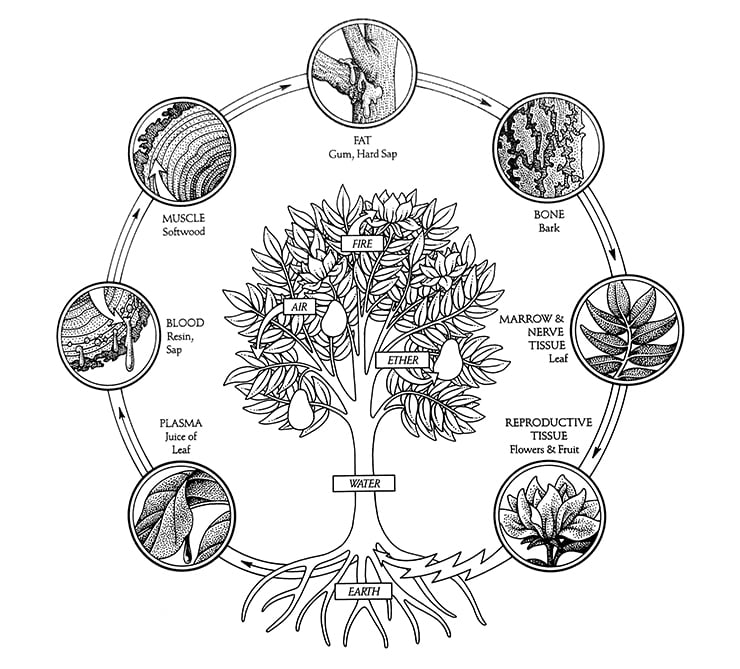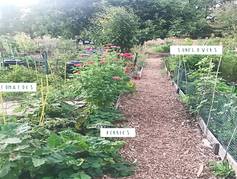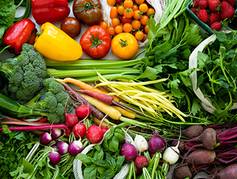Articles
Ayurveda Spotlight 1: Dhatus of Plants and Immunity
Articles
Ayurveda Spotlight 1: Dhatus of Plants and Immunity
I was introduced to one of my favorite books called The Yoga of Herbs by Dr. David Frawley and Dr. Vasant Lad during my Ayurvedic studies. It is an amazing overview and compilation of herbs – both Eastern and Western – through the Ayurvedic / energetic lens. I had already learned about dhatus in relation to the human body but the understanding of what they are and how they function in ALL living things really hit home when I came across a beautiful illustration of dhatus in plants.
This is the first article in a series on Ayurveda and health. A little about me: In 2008, I received my Clinical Ayurvedic Specialist and Pancha Karma Specialist Certification from California College of Ayurveda. I also studied Vastu Architecture for nine years with a program founded by well - known temple architect Dr. V. Ganapati Sthapati. There are so many connections between art, design, mathematics, structure and wellbeing and I am beyond excited to share some of these concepts and perspectives. When you are shown a language that shows how nature functions and then see how the body is operating under the same systems, a sort of gestalt is made clear between form and function. We see how everyone is unique yet the language is in place to know what actions are needed to restore balance no matter what the concern. No doubt, ancient sciences hold timeless wisdom.
Srotas and Dhatus
The topic is much more complex than this overview, but will try to simplify it into the main components. Srotas are channels in the body through which what we ingest (as food, drink, emotion, etc.) flows. After what we ingest is ideally broken down with the fire (agni) in the stomach, the purified material then travels through the body and eventually invigorates and creates our tissues. There are Seven main channels and the tissues created and supported by the nutrients are called the Seven Dhatus. There are a few theories on how this happens specifically, but the main idea is that it flows in a set order with each channel taking the material it needs. Each channel takes five-seven days to get what it needs — meaning the food you eat today will take 35 – 49 days to generate the final dhatu. What is left over (if anything) helps build our immunity. (Side note: Nutrients can reach systems in a faster way through the use of things like carrier oils and is another factor to be considered which can change the timing). The order the nutrients flow - and tissues created / reinvigorated - within the body is as follows:
1_ plasma (rasa dhatu)
2_blood (rakta dhatu)
3_muscle (mamsa dhatu)
4_fat (medas dhatu)
5_bone (asthi dhatu)
6_nerve (majja dhatu)
7_reproductive (shukra dhatu)
Why is this Important?
Many of us are trying to build and maintain our immunity and - in order to build it and keep it strong - we need to consume foods which have the capacity to reach all the way to the end of the line. We also can see how if one of the channels is deficient or in excess, this imbalance can often create issues for the dhatus further down the chain. And we can also see the importance of healthy digestion. One thing to note is that digestion is not only in the stomach, Digestive fires live throughout the system – for example the liver and skin have their own fire capacity. The Dhatus actually each have their own digestive gateway called a Kala. It is almost like a filter which will only let pass in what that specific channel requires. And it is a source of refinement, discernment (fire). When we have proper functioning fires in the body, all channels are satiated and thrive. And the accumulation of this abundance is what we consider immunity. The Ayurvedic term is called Ojas. In Ayurvedic Medicine by Sebastian Pole, it is described as follows:
“Ojas holds a special place in Ayurveda as its quality and quantity have a direct effect on the quality of life. ‘When ojas is low the person is fearful, weak, worried, has deranged senses, poor complexion, weak mind, is rough and thin’ (Caraka Samhita Sutrasthana 17.73). Its beneficial qualities are seen in the lustre of the eyes, strength of the body, resistance to disease, efficient digestion, potent fertility and lucidity of the mind.”
While it is not bad in any way to take vitamins (for example) to build immunity, there is nothing that can replace eating real, fresh, unprocessed foods - plants and herbs - that our body can easily convert to ojas. Which is where the amazing plant dhatu illustration comes in! Not only do humans have dhatus but plants do also.
The Seven Dhatus in Plants

Copyrighted image. Used with permission from The Yoga of Herbs: Ayurvedic Guide to Herbal Medicine, Lotus Press, lotuspress.com, Twin Lakes, Wi. © 1993 All Rights Reserved.
Dhatus in Plants
When you observe a plant – let’s take a tree as an example – we see each of the seven dhatus present. As highlighted in The Yoga of Herbs, the juice of the leaf represents the plasma channel. The resin and sap represent the blood channel, the softwood represents the muscle. The gum or hard sap represents the fat channel, the bark represents the bone channel, the nerve channel is represented by the leaf structure itself, while the fruit represents the reproductive channel. Here’s what is so amazing: not only do plants have all seven dhatus, but the PARTS of the plant we consume will have a direct effect on the corresponding dhatus within our own bodies. Examples include cinnamon (a bark), known to help lower inflammation in the nervous system; agave and maple syrup (sap) work on the blood in a way that is much different than cane sugar. Boswellia serrata (Indian frankincense), a hard resin, is known to work on fatty tumors.
Benefits and Conclusions
This information can add a whole new targeted dimension to what we choose to eat and juice. Not only that, we can see how any juices we drink will target the plasma and blood first and will therefore see results quickly in those areas. We may decide to choose specific foods corresponding to an area of concern. Also, we can see how there may be a benefit to juicing over a period of time and making it part of our daily experience. For those with challenged digestion - or anyone really - juice can play a key role in helping build immunity more quickly given it is easier to assimilate. Immunity is created in time with habits which consistently uplift the system. Of course there are more things that help generate ojas beyond food (such as breathwork, daily habits, positive emotions, etc.), but food is a main component. Herbs can also be juiced to provide amazing benefits – they can be selected to work on opening up channels so they can flow properly or selected to rebuild channels that are depleted. Plants are truly a gift worth exploring.
sources:
Frawley, D., & Lad, V. (2016). The Yoga of Herbs: An Ayurvedic Guide to Herbal Medicine. Delhi: Motilal Banarsidass.
Pole, S. (2013). Ayurvedic Medicine: The Principles of Traditional Practice. London: Singing Dragon.
- Choosing a selection results in a full page refresh.
- Press the space key then arrow keys to make a selection.
.jpg%3Fv%3D0&c_options=w_237,h_179)


